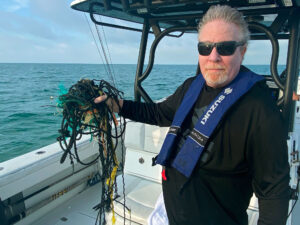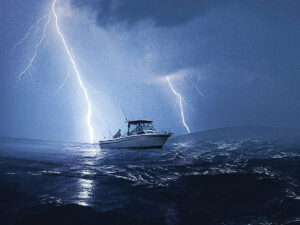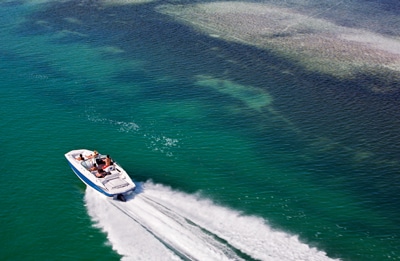
When two boaters talk about a run down the coast, and one says he’s going off shore while the other says he’s taking the inside route, it’s the guy who’s heading out of the inlet who comes off as Mr. Macho and the other as Capt. Chicken — afraid to go out into the big, bad ocean.
But that perspective is way out of touch with reality.
Anyone can make a straight line from one sea buoy to the next. just point the bow and hang on. But to get through the confusing traffic, sweeping currents and poorly marked serpentine channels of an inshore route, well, that takes seamanship and talent. That takes a real man.
Outs and Ins
I get a call from john the night before we’re to take our boats south to kick off our vacations.
“We’ll meet at the gas dock around 7 and be out of the inlet by 8,” he says.
“OK,” from me, ashamed of what was next. “My wife’s coming along so I have to take the inside route.” A long pause and …
“Got you by the short ones, huh?” You could hear the smirk. “Ah, don’t worry, buddy, I’ll meet you down there.” Click.
The next morning john and his friend Mark turn to head out of the inlet. As I watch them smash through the rollers, I feel like one of those spineless guys you see following his wife around a furniture store. Then again, I’m the one at the helm with a cup of hot joe and a bagel while John’s all white knuckles and already encrusted with salt. This may not be so bad after all.
Distorted Line of Sight
Going inside is never boring. There’s always something to see, and you’re always busy. Off shore all you see is water, hour after boring hour of water. Sure, you get where you’re going faster, but to me the idea of going boating is not to make time — it’s to spend time. Although right now I can see that it’s not going to be easy.
I’m in a channel with a strong crosswind. If I just aim at the next marker, I could be pushed sideways onto a shoal. So I envision a line between the mark I’m headed for and the last marker I passed on my downwind side. If I’m on the channel side of the line, I’m safe.
It’s dangerous to only look ahead, and even more so if you don’t know how to aim your boat. Don’t use the tip of the bow as your guide if your helm is off to port or starboard. You’ll be looking at an angle to the boat’s actual heading. To aim a boat accurately, you have to sight down the centerline, or a line parallel to it. use a stanchion, a cleat or even a strip of tape on the deck directly in front of you to line up your forward sight. And keep checking the marker or point of reference behind you to make sure you’re still running a straight line.
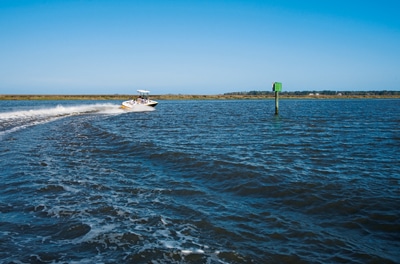
Best Nav Skills: Dog or Duck?
We enter a bay where the crosswind is even stronger, heading for a marker at the opening of a canal on the other side. If I follow a compass course, I’ll end up somewhere downwind of my destination, being swept sideways as I travel forward.
To compensate for this, many boaters find a landmark and aim for it — just as a dog would do if it had to swim across a river. He’d get there, but it would be a long swim in an ever-increasing arc. A duck, however, knows enough to correct for the current and angle slightly to windward of the mark, giving him a straight run and the shortest course. So, to compensate, I’ve added about five degrees to windward on my compass course.
Speaking of ducks, when I called john on the radio, all I got were grunts and quacks. He could barely talk as they were pounding along. “Must be way ahead of us,” I say to myself as I put my drink down with no fear of it spilling.
Ultimate Pass or Fail
We enter the canal and are coming up behind a sailboat under power, which means problems. By law we’re now both considered powerboats, but he still has the right of way until I pass him. Also, sailboaters tend to be grouchy. They expect you to pass without leaving any wake.
He’s going about 4 mph, so to pass in a reasonable time, I’ll have to be going a speed that kicks up a nasty wake. I call Channel 16 to tell him that, if he slows down, I can pass without shaking his rigging. He signals back and slows to 2 mph; we go creeping by at 5 mph, and everyone’s happy.
Next obstacle is an oncoming tug pushing a raft of barges. Since the tug’s captain has a high view of what’s going on, I call him on 13 to see which side he wants me to pass on. Down south, in the heart of barge traffic, you’ll often get a confusing reply such as “come by on the one, cap” or “on the one whistle.” This refers to the signal used when approaching port-to-port. Or he’ll say “on the two,” meaning starboard-to-starboard.
Going by something this big in a tight canal is another adventure. The barges act like a huge plunger in a pipe (the canal), moving a lot of water — and you — with it. As we get close to the first barge, our bow gets pushed hard toward the bank before being sucked back in toward the barges as they pass. Then, when the tug passes, the wash from its huge prop pushes us back out again. As long as you know what to expect, there’s no problem. But I’m still glad that’s over with.
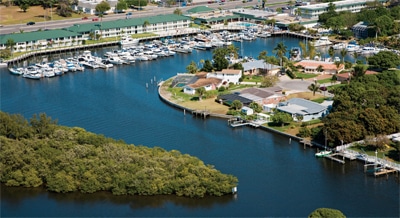
The Impromptu Shore Lunch
There’s a bridge ahead, but when we call for an opening, we’re told that we’ll have to wait for a half-hour. We can make circles, which is a pain, or anchor, which will take about 30 minutes to do right. So I try an old tugboat trick. While waiting to pick up barges, tugs often nudge up to the shore. I’ve seen them parked bow first, right into the trees, with their engine just ticking over to hold them in place.
The bank here is a muddy beach, and the chart shows a sharp drop-off . I slowly head in, using the boathook as a sounding pole. I poke the bottom as we go in, watching what the hook brings in. Muck, sand or grass is fine. If we hit something hard with the tip, like rocks or tree stumps, we’ll back away. Once on the beach, I leave the engine running a notch above idle, to pin us to the bank, and turned slightly, to counter the gentle current. The problem with this technique is that you can’t use it where there are waves or wakes. But it’s dead-calm here so we’re fine.
Once secure, we sit back in the sun to have a quiet lunch while listening to the birds. I can only imagine the lunch john and Mark are having.
On Alert!
We back off the beach, get under the bridge and enter another bay. It is here that I’m reminded about how much navigating is involved when going inside. You need to stay on top of where you are at all times. Off shore, john is just setting courses from one sea buoy or waypoint to the next, so it’s tough to get into trouble. It’s different here. I’m traveling chart-in-hand, or eyes on the chart plotter, all the time.
A break in concentration almost puts us on a sandbar. It’s easy to do on large, shallow bays where markers are widely spaced and the tight channels make unexpected doglegs. I’m at one buoy, see what I think is the next, head for it and then watch the depth sounder go into single digits. I’d inadvertently cut a corner by not passing the next marker in the numbered series. The best way to avoid this is to locate the next one by using a compass bearing. This way, anything too far off to one side will be obvious. And always keep track of the marker numbers.
So, we’re plotting our track and counting marker numbers until the next one looks to be two miles away. Between it and us is a nasty shoal to port — along with this stiff crosswind. To stay off the rocks, I do some chart work.
I draw a line from the buoy along the outer edge of the shoal and write down its bearing. This is my “danger bearing,” a safety barrier over which I must not cross. I then draw a second line that will be my “safety bearing.” This stands off from the hazard by a good margin and will be the course I try to steer. While under way I watch to see how my bearings change toward the marker, telling me if I should be steering higher or lower to remain safe.
Day and Night
I like to be in early to make sure I have daylight to anchor or tie up for the night. But this day is going a little longer.
We finally see the outer day-marker for the channel that leads into the marina. As we approach, it’s tempting to start turning in when our bow is even with the pole, but that shortcut can often lead to a grounding. The safest bet is to wait until you can look down the channel and see the buoys line up on both sides, then make the turn and call the dockmaster for an assigned slip.
A little later John and Mark, who have been in for a few hours, come over for an unpleasant dinner over their not-so-subtle jabs about me going inside and my wife’s undercooked pasta. After they leave, she gives me this look.
“You worked your butt off all day,” she says. “All they did was drive in a straight line … and you’re the weenie?”
“It’s a guy thing,” I tell her. “You wouldn’t understand.” But then again, neither do I.
When Going Outside, Don’t Forget …
Locating Device – Use an EPIRB, GPIRB or even a PLB (personal locator beacon), and make sure you apply for a maritime mobile service identity number for your VHF DSC radio. To get an MMSI, go to usps.org.
Freshwater Windshield Washer – If you get salt spray on the windshield and turn on the wipers, you’ll get white smears. Only fresh water will rinse the mess off. Carry some in the type of dish-soap bottle that has a squirt nozzle.
Foot Cushions – Even if it’s calm, you’ll be standing a lot. Shock-absorbing pads for the cockpit sole will make the trip a lot more comfortable.
When Going Inside, Don’t Forget …
Binoculars – Just a good set of 7x50s with clean lenses will do, to keep track of markers and boats.
Long Boathook – Use it as a sounding pole — the longer the better. Solid ones are ideal; telescopic ones are fine if they don’t collapse easily.
Hand-Bearing Compass – You need only an inexpensive “puck” type. It’s a must for finding markers, getting lines of position and seeing if you and that crossing boat are going to collide.

